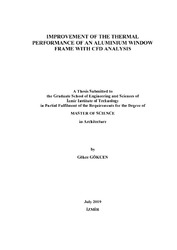Please use this identifier to cite or link to this item:
https://hdl.handle.net/11147/7416Full metadata record
| DC Field | Value | Language |
|---|---|---|
| dc.contributor.advisor | Başaran, Tahsin | - |
| dc.contributor.author | Gökçen, Gökçe | - |
| dc.date.accessioned | 2019-12-03T06:29:01Z | |
| dc.date.available | 2019-12-03T06:29:01Z | |
| dc.date.issued | 2019-07 | - |
| dc.identifier.citation | Gökcen, G. (2019). Improvement of the thermal performance of an aluminium window frame with CFD analysis. Unpublished master's thesis, İzmir Institute of Technology, İzmir, Turkey | en_US |
| dc.identifier.uri | https://hdl.handle.net/11147/7416 | - |
| dc.description | Thesis (Master)--Izmir Institute of Technology, Architecture, Izmir, 2019 | en_US |
| dc.description | Includes bibliographical references (leaves: 65-70) | en_US |
| dc.description | Text in English; Abstract: Turkish and English | en_US |
| dc.description.abstract | Most of the primary energy used in the world belongs to fossil fuels. Energyefficient activities are carried out in many different sectors in order to prevent the depletion of the reserves of these resources. The building sector is one of them and many different studies are being carried out to reduce the energy consumed in the buildings. Windows are the main unit of heat losses and gains in buildings. In literature, the main reasons for heat losses through windows are usually stated as glass units due to their large areas and relatively higher overall heat transfer coefficient. However, windows frames are as important as glass units because they also have higher heat transfer. Since the most commonly used material in window frames, which is aluminium, has the highest thermal conductivity value, this topic should be investigated. In this study, two different strategies are presented to improve the thermal transmittance of an aluminium frame without changing the frame geometry. The first strategy presented is the improvement of the gasket and thermal break materials in which high thermal conductivity materials are used which have a considerable impact on the thermal performance of aluminium window frames. The second strategy is to fill the cavities in aluminium profiles with polyurethane foam in order to reduce convection effects. Two dimensional CFD simulations of the aluminium window frame, modelled with information from the manufacturer, were used to investigate these improvement strategies. As a result of the study, the importance of thermal break and gasket materials used in the aluminium window frame has been seen and the thermal conductivity of these materials has a considerable effect on the thermal performance of the windows. Moreover, the polyurethane foam filled air cavities in the aluminium frame have positively affected the thermal performance of window as proposed and %29.44 improvements occurred. | en_US |
| dc.description.abstract | Dünyada kullanılan birincil enerjinin büyük bir kısmı fosil yakıtlara aittir. Bu kaynakların rezervlerinin tükenme ihtimaline karşı birçok farklı sektörde enerji etkin çalışmalar yürütülmektedir. İnşaat sektörü de bunlardan biridir ve binalarda tüketilen enerjiyi azaltmak için günümüzde birçok farklı çalışma yürütülmektedir. Binalarda enerji kayıp ve kazançlarının en çok gerçekleştiği elamanlar ise pencerelerdir. Literatürde, pencerelerin neden olduğu ısı kayıplarına bağlı araştırmalar, genellikle kapladıkları alan ve toplam ısı geçiş katsayısına görece fazla olmasından dolayı cam ünitelere aittir. Oysa pencere çerçeveleri de yüksek ısı geçişine sahip olmaları nedeniyle, en az cam üniteler kadar önemlidir. Çerçeve malzemesi olarak kullanılan alüminyum ise ısı geçirgenliği en fazla olan malzeme olduğu için üzerinde çalışılması gereken bir konudur. Bu çalışma kapsamında, alüminyum pencere çerçevesinin termal geçirgenliğini çerçeve geometrisini değiştirmeden iyileştirmek için iki farklı strateji sunulmuştur. Sunulan ilk strateji, alüminyum pencere çerçevesinin termal performansı üzerinde oldukça fazla etkiye sahip olan yüksek termal iletkenliğe sahip malzemelerin kullanıldığı conta ve termal kırılma malzemelerinin iyileştirilmesidir. İkinci strateji ise, havanın taşınım etkisini azalmak için alüminyum profiller için de yer alan boşlukların poliüretan köpük ile doldurulmasıdır. Bu iyileştirme stratejilerini araştırmak için üreticiden alınana bilgilerle modellenen alüminyum pencere çerçevesinin iki boyutlu CFD simülasyonları kullanılmıştır. Çalışma sonucunda, alüminyum pencere çerçevesinde kullanılan termal kırılma ve conta malzemelerinin önemi görülmüş ve bu elemanlarda kullanılan malzemelerin termal iletkenlik değerinin pencere çerçevesinin termal performansını oldukça fazla etkilediği ortaya çıkmıştır. Bunun yanında, öngörüldüğü gibi alüminyum profilde poliüretan köpükle doldurulmuş hava boşlukları, pencerenin termal performansını olumlu olarak etkilemiş, % 29,44 iyileşme meydana gelmiştir. | en_US |
| dc.format.extent | xiv, 70 leaves | - |
| dc.language.iso | en | en_US |
| dc.publisher | Izmir Institute of Technology | en_US |
| dc.rights | info:eu-repo/semantics/openAccess | en_US |
| dc.subject | Aluminium frame | en_US |
| dc.subject | Window design | en_US |
| dc.subject | Thermal performance | en_US |
| dc.subject | Energy consumption | en_US |
| dc.subject | CFD analysis | en_US |
| dc.title | Improvement of the Thermal Performance of an Aluminium Window Frame With Cfd Analysis | en_US |
| dc.title.alternative | Had Analizi ile Bir Alüminyum Pencere Çerçevesinin Isıl Performansının İyileştirilmesi | en_US |
| dc.type | Master Thesis | en_US |
| dc.institutionauthor | Gökçen, Gökçe | - |
| dc.department | Thesis (Master)--İzmir Institute of Technology, Architecture | en_US |
| dc.relation.publicationcategory | Tez | en_US |
| dc.identifier.wosquality | N/A | - |
| dc.identifier.scopusquality | N/A | - |
| item.grantfulltext | open | - |
| item.fulltext | With Fulltext | - |
| item.languageiso639-1 | en | - |
| item.openairetype | Master Thesis | - |
| item.cerifentitytype | Publications | - |
| item.openairecristype | http://purl.org/coar/resource_type/c_18cf | - |
| Appears in Collections: | Master Degree / Yüksek Lisans Tezleri | |
Files in This Item:
| File | Description | Size | Format | |
|---|---|---|---|---|
| T001955.pdf | MasterThesis | 2.18 MB | Adobe PDF |  View/Open |
CORE Recommender
Page view(s)
360
checked on Jun 16, 2025
Download(s)
1,050
checked on Jun 16, 2025
Google ScholarTM
Check
Items in GCRIS Repository are protected by copyright, with all rights reserved, unless otherwise indicated.